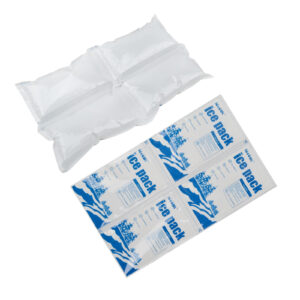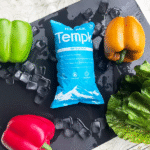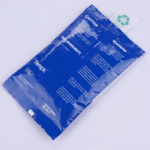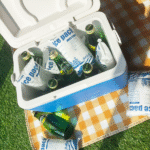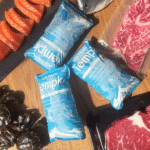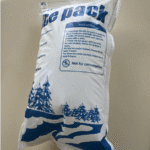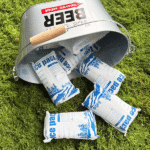Packs de glace sec xl: Comment dimensionner et expédier 2025
Mis à jour: Août 18, 2025 — 7–9 min read
Si vous expédiez des denrées périssantes, dry ice packs xl help you hold temperature longer with fewer pieces and simpler handling. Use XL gel or PCM packs for 2–8 °C and most frozen lanes; move to dry ice only when you need ultracold or extra‑long routes. Plan dry ice at ~5–10 lb per 24 h, and remember USPS caps air mail at ≤5 lb per piece. Validate with lane tests and a logger.
-
Comment dry ice packs xl differ from dry ice, and when to choose each
-
XL sizes, dimensions, and fit tips for 24–96 h lanes
-
A copy‑and‑paste packout estimator for gel/PCM and dry ice
-
2025 règles: Et1845, Étiquette de classe9, masse nette, ventilation (air & postal)
-
Tendances: −21 ° C PCM, drain‑safe gels, EPR‑driven reuse programs
What are “dry ice packs xl,” and when should you use them?
Réponse courte: Dry ice packs xl are extra‑large gel or PCM bricks (often 48–64 oz) that hold a target band (Par exemple, 2–8 °C or −20 °C class) without hazmat steps. Use them for chilled or moderate frozen shipments. Choisissez de la glace sèche (co₂ solide à -78,5 ° C) for ultracold targets or long, hot lanes where gel/PCM cannot hold.
Pourquoi ça compte: Gels and PCMs “park” temperature near their phase point, reducing freeze damage to sensitive foods or biologics. Dry ice drives far colder and lasts longer but triggers UN 1845/Class 9 labeling and venting. A practical default: dry ice packs xl for 2–8 °C and many frozen SKUs; dry ice only when route risk demands it.
XL sizes and fit for dry ice packs xl
Standardized XL footprints let you design once and dual‑source later.
| XL Reference | Poids typique | Taille typique (L×W×H) | Ce que cela signifie pour vous |
|---|---|---|---|
| XL Gel Pack | 48 oz | ~10.25″×7.75″×1.5″ | Fewer pieces for 48–72 h lanes; easy training. |
| XL+ Gel/PCM | 64 oz | ~11″×8″×2″ | Higher cold mass for 72–96 h; reduces air gaps. |
| −21 °C PCM Brick | 48–64 oz | 7–10″×11″ class | Subzero holds without −78.5 °C overcooling. |
Fit tip: Tight fit beats extra mass. Eliminate voids before adding more coolant. For freeze‑sensitive payloads, buffer with corrugate or switch to 4–5 °C PCMs.
Conseils pratiques que vous pouvez utiliser aujourd'hui
-
Condition préalable: Freeze gels/PCMs solid (24–48 h at ≤−18 °C); pré-refroidir l'expéditeur.
-
Placement: Pour gel / pcm, ring the sides and lid; pour la glace sèche, place on top and keep vents clear.
-
Fruit de mer: Never use dry ice with live seafood—use gel/PCM only.
Résultat réel: A frozen treat brand swapped four 32 oz packs for two 64 oz dry ice packs xl plus a small summer dry‑ice “topper.” RMAs fell by ~70% and delivery windows widened by 6–10 h on hot lanes.
Combien dry ice packs xl Avez-vous besoin?
Démarrage rapide: Pour 2 à 8 ° C, target ~1 lb gel per ft³ per 24 h as a starting point. For −20 °C class, test −21 °C PCM first; add a small dry‑ice booster only if trials fail. If you must use dry ice, plan ~7.5 lb per 24 h as a midpoint and label UN 1845 with net mass (kg). Always validate on your route.
Copy this estimator and tweak for your lane:
Important: Isolation, ajuster, préconditionnement, and ambient drive outcomes. Use a data logger and run 2–3 pilots before scaling.
Which cooling path fits your target?
| Option de refroidissement | Cible typique | Planning signal | Ce que cela signifie pour vous |
|---|---|---|---|
| XL Gel (0 ° C) | 2–8 ° C | 24–48h (insulation‑dependent) | Kits de repas, laitier; pas de danger. |
| XL PCM −16/−21 °C | Soft to deep frozen | 24–72h | Subzero without ultracold risk; manipulation plus sûre. |
| Glace sèche (−78,5 ° C) | Profondément infrogé / ultracold | ~ 5 à 10 lb par 24h | Long/hot lanes; étiquette, secouer, record net mass. |
Conseils exploitables
-
Short summer lanes (≤48h): 2–3 dry ice packs xl per ~5 kg payload, placed around sides and lid.
-
Glace (−12 to −18 °C): Run XL −21 °C PCM around the perimeter; add a small dry‑ice topper in July/August.
-
Clinical swabs/vials (ultrafroid): Vented dry‑ice shipper; list UN 1845 and net mass (kg) on the label/air waybill.
Glace sèche vs dry ice packs xl: which is right for your lane?
Fin de compte: Choisir dry ice packs xl for most refrigerated and many frozen shipments. Use dry ice for −70 °C class or long, voies chaudes. Dry ice is regulated as UN 1845 (Classe9), nécessite un emballage ventilé, and must show net dry‑ice mass (kg). USPS air mail is limited to ≤5 lb per piece.
2025 étiquetage & liste de contrôle de ventilation (air & postal)
-
Marque Et1845 and display a Classe9 diamant de danger (≥ 100 mm).
-
Record masse nette de glace carbonique (kg) on the label/air waybill.
-
Keep the shipper ventilé; ne jamais sceller la neige carbonique dans un récipient hermétique.
-
Air USPS: ≤5lb glace carbonique par envoi postal; additional packaging/marking rules apply.
Note de sécurité: CO₂ exposure limits matter on pack lines and in vehicles. OSHA 8‑h TWA is ~5,000 ppm; NIOSH STEL is ~30,000 ppm. Ventiler, moniteur, et s'entraîner.
2025 conformité & EHS for dry ice packs xl et glace sèche
-
Iata 2025: Use the current acceptance checklist for dry ice as a refrigerant; no DG declaration is needed when cooling non‑dangerous goods, but UN 1845, masse nette, et la ventilation sont obligatoires.
-
Spécificiaires du transporteur: Follow UPS/FedEx job aids for label size and wording; check operator variations before booking.
-
USPS Pub 52 (Air): ≤5 lb cap per mailpiece; surface services can exceed.
2025 trends in cold chain and dry ice packs xl
-
Reusable −21 °C PCM “dry‑ice alternatives”: More lanes can avoid hazmat while meeting subzero targets; Valider sur votre itinéraire.
-
Drain‑safe & “no‑sweat” gels: Better unboxing and simpler disposal guidance for DTC programs.
-
Dynamique EPR: Oregon’s Recycling Modernization Act launched July 1, 2025; CA/CO/MN are in 2025 phases. XL PCM programs and take‑back loops reduce single‑use refrigerant waste.
Questions fréquemment posées
Q1: Are “dry ice packs xl” literally dry ice?
Non. They are extra‑large gel or PCM packs that avoid dry‑ice hazmat steps. Use them for 2–8 °C or moderate frozen; reserve dry ice for ultracold or long, routes chaudes.
Q2: How many dry ice packs xl for 36 h at 2–8 °C?
Commencer à proximité 0.25 pack‑mass per kg payload and add a summer factor (Par exemple, ×1.2). Validate with a logger and a small pilot.
Q3: Will frozen gels freeze vaccines?
Oui, ils peuvent. For refrigerated biologics, use 4–5 °C PCMs and add a buffer layer.
Q4: Can I mail dry ice?
Oui, au niveau national, but USPS air caps dry ice at ≤5 lb per mailpiece and requires specific packaging and venting.
Q5: How fast does dry ice “disappear”?
Plan on ~5–10 lb per 24 h; add a day of margin for delays. Test on your lane.
Résumé & recommandations
Utiliser dry ice packs xl for most 2–8 °C and many frozen shipments; switch to dry ice for ultracold or extended summer routes. Precondition packs, eliminate voids, and place gels/PCMs around the sides and lid. If dry ice is present, étiquette UN1845, display the Class 9 diamond, record net mass (kg), and vent the box. Validate with pilots and a logger before you scale.
Étapes suivantes (CTA):
-
Map SKUs by temperature target and route duration.
-
Pilote deux emballages (XL PCM‑only vs. hybrid with a small dry‑ice topper).
-
Standardize label/vent SOPs where dry ice appears.
-
Launch an XL PCM return/reuse loop to support 2025 EPR goals. Talk to Tempk for a fast packout audit.
À propos du tempk
Nous concevons, test, and standardize passive cold‑chain packouts that cut costs without risking payloads. Our team specializes in XL PCM bricks and gel systems for 2–8 °C and frozen lanes—and compliant dry‑ice workflows when required. Clients see fewer out‑of‑spec deliveries and lower shipping costs through accurate sizing, meilleure isolation, and clear SOPs aligned with 2025 règlements.






